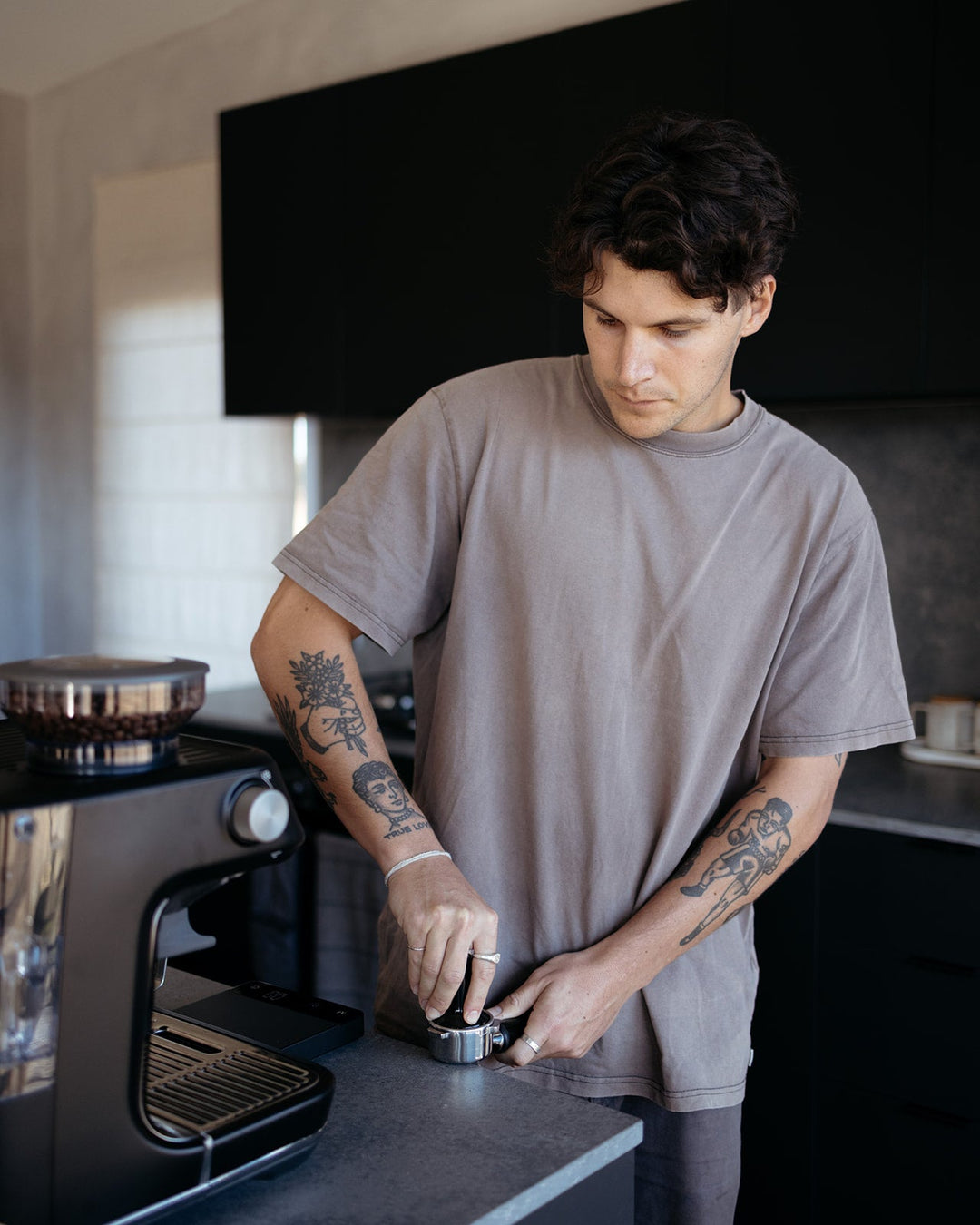What Makes SOE Single Origin Espresso Unique from Mixed Roasts
What Makes SOE Single Origin Espresso Unique from Mixed Roasts
Blog Article
Coffee Beans Uncovered: Discovering the Keys of Coffee and Blended Coffee Beans
When you consider coffee, what comes to mind? Is it the rich fragrance of coffee or the intricacy of a well-crafted blend? Understanding the nuances of coffee beans can transform your experience. Each selection, from Arabica to Robusta, holds its very own keys. As you discover further, you'll discover exactly how these beans shape flavors and effect sustainability. What might you discover concerning your following cup?
The Origins of Espresso: A Historical Point Of View
Although espresso is now a staple in coffee culture worldwide, its origins map back to the very early 20th century in Italy. You may be shocked to find out that the invention of espresso was driven by a wish for speed and effectiveness. In 1901, Luigi Bezzera patented the very first espresso maker, aiming to make coffee faster than conventional methods. This advancement quickly recorded the attention of Italian coffee enthusiasts, resulting in the coffee bars we recognize with today.
Comprehending Espresso Beans: Selections and Features
When you consider espresso, it's important to identify the various bean ranges and their special tastes. Each kind brings an unique personality to your mug, affected by elements like roast degrees. Understanding these components can boost your coffee experience significantly.
Coffee Bean Varieties
As you explore the globe of coffee, you'll rapidly find that not all beans are produced equivalent; each variety brings its very own one-of-a-kind flavors and attributes to your cup. Arabica beans are recognized for their smooth, nuanced flavors and lower high levels of caffeine web content, making them a preferred among coffee lovers. Each range uses something different, so experimenting will assist you discover your excellent coffee.
Taste Accounts Discussed
Recognizing the flavor accounts of various coffee beans can elevate your coffee experience. Each bean selection provides one-of-a-kind features that affect scent, preference, and mouthfeel. For instance, Arabica beans frequently offer a sweeter, extra intricate taste with tips of fruit and flower notes, while Robusta beans tend to be bolder, with nutty and earthy undertones.
When you check out single-origin beans, you could find distinct local flavors-- Main American beans might be brilliant and citrusy, whereas Italian blends typically supply abundant, chocolatey notes.
Roast Degrees Effect
Roast degrees play a necessary role in forming the taste and aroma of coffee beans, affecting your total coffee experience. Comprehending these roast degrees helps you choose the espresso that fits your taste choices. Exploring with different roasts can lead to delightful discoveries, enhancing your gratitude for espresso.
The Art of Blending: What Makes Blended Coffee Unique
What makes combined coffee so fascinating? It's all concerning the art of incorporating beans from various origins, roast levels, and taste accounts. You're not simply blending; you're producing an unified equilibrium that highlights the strengths of each bean when you blend. You can explore different combinations to boost sweet taste, level of acidity, and body, leading to a mixture that's richer and a lot more complicated than a single-origin coffee.
Plus, mixing can help preserve uniformity, supplying a trusted flavor experience no matter of seasonal variations in beans. Whether you're a home or a barista brewer, understanding the art of blending opens up a globe of creative thinking and flavor opportunities, making your coffee experience really one-of-a-kind.
Flavor Profiles: Tasting Notes of Coffee vs. Blended Coffee
Mixed coffee offers a globe of flavor possibilities, however when it comes to coffee, you're looking at an extra concentrated experience. Espresso commonly showcases bold, rich tastes with a thicker mouthfeel.
On the various other hand, combined coffee offers an intricate tapestry of flavors. You can check out a range of sampling notes, from sweet and nutty to floral and fruity. Each mix can provide something special, frequently integrating beans from different regions to produce a well balanced account.
While coffee delivers a punch, mixed coffee invites you to enjoy the subtleties. Whether you favor the durable toughness of coffee or the complex tastes of blended coffee, each mug informs its own tale, awaiting you to discover.
Brewing Techniques: Developing Your Espresso Shot
To achieve the perfect coffee shot, comprehending the developing strategies is crucial, as even minor modifications can substantially influence the taste and high quality. Beginning by utilizing fresh, high-quality coffee beans; grind them prior to brewing for maximum flavor. Aim for a great grind, regarding the consistency of table salt, to assure suitable extraction.
Next, take note of your water temperature level; it needs to be in between 195 ° F to 205 ° F. Too warm or too cold can wreck your shot. Use about 18-20 grams of coffee for a dual shot, and tamp it evenly with strong stress to create a consistent puck.
Finally, regulate your removal time; go for 25-30 secs. A longer extraction can cause anger, while too brief can lead to sour flavors. Practice these techniques regularly, and you'll refine your abilities, achieving that rich, full-bodied coffee shot you long for. Enjoy the journey!
The Duty of Roast Levels in Espresso and Blended Coffee
After understanding the brewing methods for coffee, it's time to ponder just how roast levels influence the flavor account of your coffee. The roast degree can significantly change your coffee's preference, body, and aroma. Light roasts tend to highlight Source the coffee's origin, offering intense acidity and fruity notes, while medium roasts balance level of acidity and sweet taste, creating an all-round taste. Visit Website Dark roasts, on the other hand, draw out strong, rich flavors with reduced acidity, commonly generating delicious chocolate or great smoky touches.

Checking Out Sustainability: Ethical Sourcing of Coffee Beans
When you pick coffee, you're not just picking a flavor; you're deciding about the influence on farmers and the setting. Understanding Fair Profession techniques, natural farming methods, and qualification standards can help you sustain sustainable coffee sourcing. Let's explore exactly how these aspects add to an extra ethical coffee experience.
Fair Profession Practices
Fair Trade techniques play an important function in making sure that coffee beans are sourced morally and sustainably. When you pick Fair Trade coffee, you support farmers who receive fair incomes and work in risk-free problems. By choosing for Fair Profession brand names, you're not simply delighting in an abundant cup of coffee; you're making a positive look here impact on the lives of those that grow it.
Chemical-free Farming Techniques
As you discover the globe of moral coffee sourcing, natural farming approaches emerge as a crucial part of sustainability. Furthermore, it usually leads to more powerful, much healthier coffee plants, resulting in richer flavors in your mug. When you decide for natural coffee, you're making a mindful choice that benefits both the earth and your taste buds.
Qualification Requirements Explained
Comprehending accreditation standards is necessary for any individual curious about ethically sourced coffee. These criteria, such as Fair Trade, Jungle Partnership, and USDA Organic, warranty that coffee is expanded under sustainable practices. When you choose accredited coffee, you support farmers that follow ethical labor techniques and ecological security.
Fair Trade certification concentrates on supplying fair salaries and functioning problems, while Rainforest Partnership emphasizes biodiversity and ecological community conservation. Following time you're at your regional coffee shop or grocery store, look for these tags, and really feel great knowing your coffee purchase positively influences areas and the environment.
Regularly Asked Questions


Just How Does Elevation Affect the Development of Coffee Beans?
Elevation influences coffee bean development by influencing temperature and climate. Greater altitudes commonly generate denser beans with more complex tastes, while lower altitudes can result in faster development however less flavorful end results. You'll taste the distinction!
What's the Difference In Between Arabica and Robusta Beans?
Arabica beans are sweeter and much more intricate, while Robusta beans have a stronger, harsher taste with greater high levels of caffeine material. You'll find Arabica preferred for specialized coffees, whereas Robusta's commonly used in instantaneous coffee and coffee blends.
Can Coffee Beans Go Negative or Lose Taste In Time?
Yes, coffee beans can spoil and lose taste over time. If you save them improperly or maintain them too long, they'll end up being stale. Constantly keep your beans in an impermeable container away from light and dampness.
What Are the Health And Wellness Advantages of Alcohol Consumption Coffee?
Drinking espresso increases your energy, improves psychological quality, and may lower the threat of particular diseases. It's rich in anti-oxidants, supports metabolic rate, and can improve mood, making it an advantageous option for your everyday routine.
How Does Water High Quality Influence Coffee Extraction?
Water quality substantially affects coffee removal. It affects the solubility of oils and flavors, influencing taste and fragrance. Using filtered water can enhance your espresso, making sure a well balanced and enjoyable cup whenever you brew.
Coffee Beans Uncovered: Finding the Tricks of Coffee and Blended Coffee Beans.
Recognizing the taste accounts of different espresso beans can elevate your coffee experience.Roast levels play a necessary function in forming the taste and fragrance of coffee beans, affecting your general coffee experience (SOE).Blended coffee provides a world of flavor possibilities, but when it comes to coffee, you're looking at an extra focused experience.After grasping the brewing methods for coffee, it's time to contemplate how roast levels affect the taste profile of your coffee
Report this page